Table of Contents
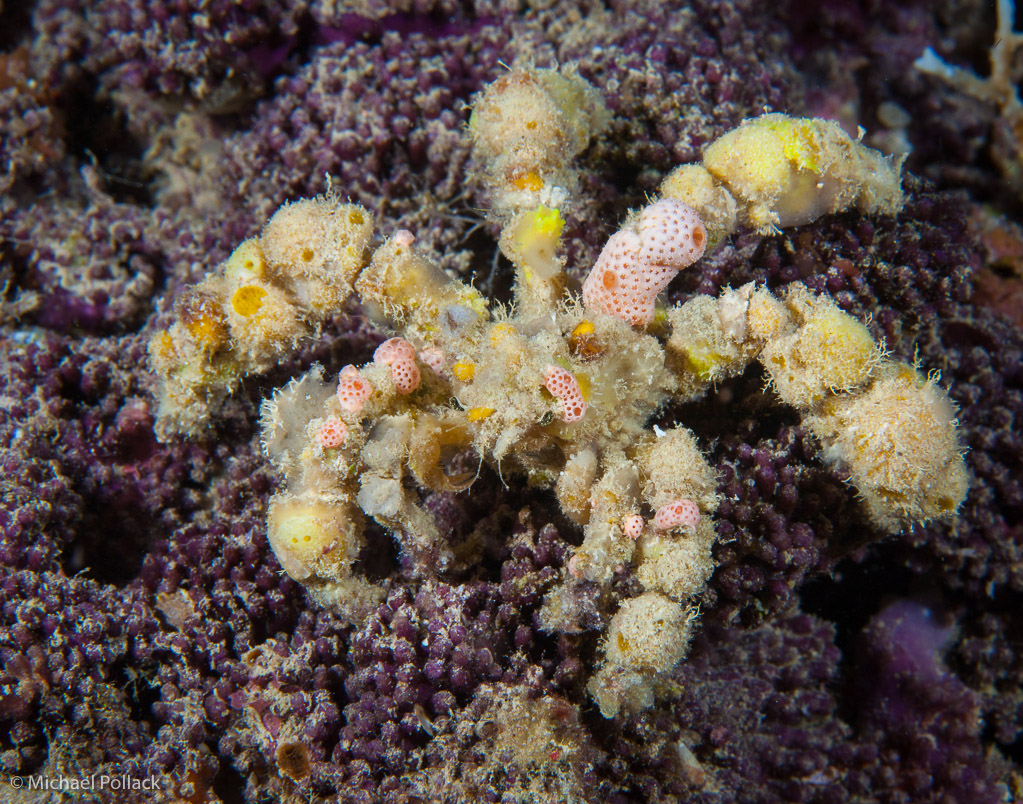 |
| Figure 1: Velcro crab. Source: Michael Pollack. Permission granted. [30] |
Ever seen a piece of seaweed or sponge moving on its own? You might want to look closer; there could probably be a Velcro crab under the moving seaweed! This crab wears a full load of decoration everywhere it goes – sometimes colourful, sometimes dull. It is also known as the spider decorator crab or Camposcia decorator crab.
Read on to find out more about this interesting crab!
1. Physical description
Usually, the Velcro crab is so heavily decorated that all you can see are its eyes and pincers. What does it look like under all that decoration?If all its decorations are removed (Figure 2), the Velcro crab is actually pretty small - it's convex and pear-shaped carapace usually only grows to a width of about 3 cm [1][2][3][4]. The species has long and curved eyestalks, which cannot be retracted [5].
The Velcro crab possesses a pair of chelae (singular: chela), which are pincer-like claws, on its first pair of pereoipods or legs. These legs are called chelipeds and are shorter than the other eight legs [2]. The 2nd to 5th pereiopods of the Velcro crab are long and slender [6], usually growing up to 10 cm. They are used for walking, hence they are also known as ambulatory legs.
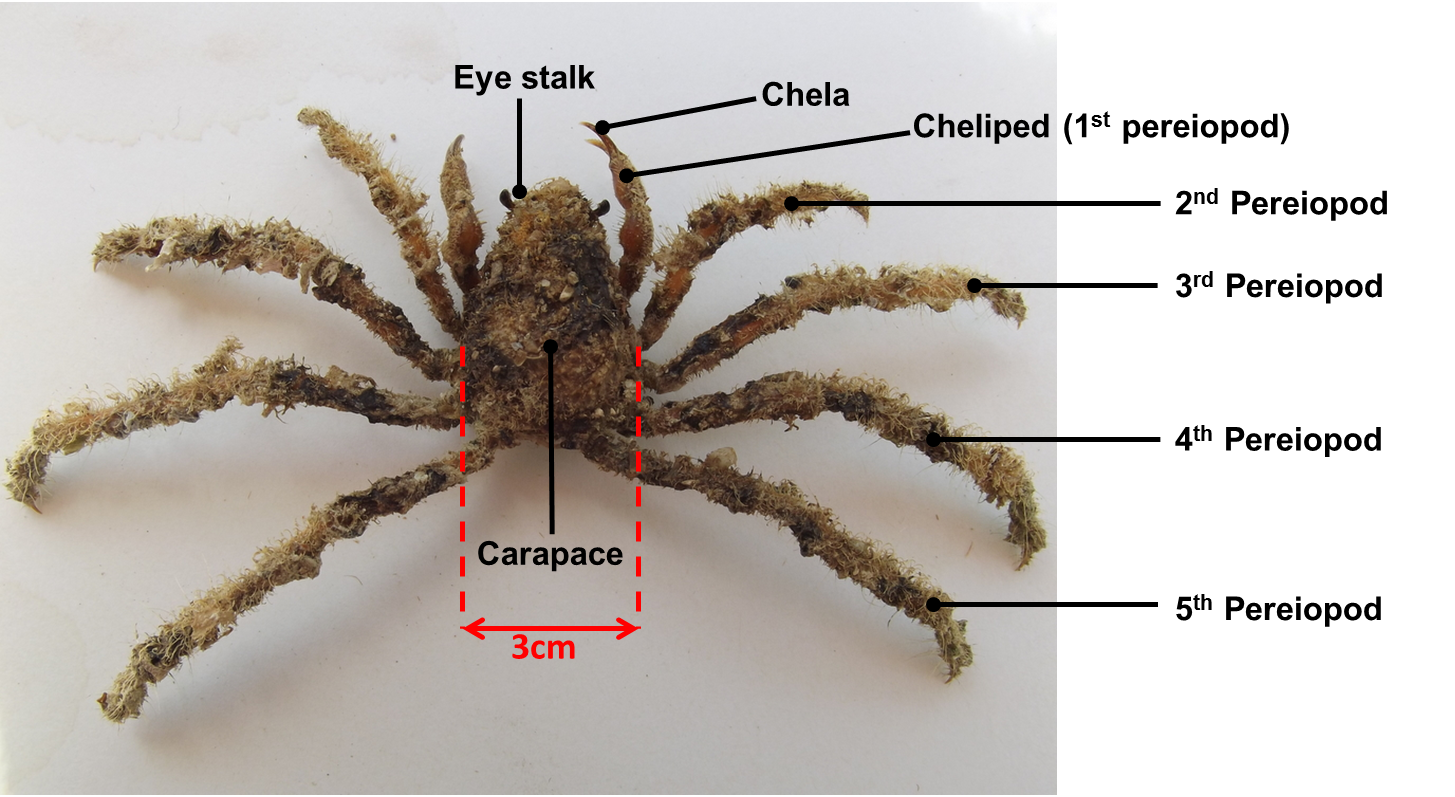 |
| Figure 2: Undecorated Velcro crab. Adapted from: Martin Lagerway. Obtained and accredited under fair use. Edited by: Nicolette Loo. [31] |
The carapace and 2nd to 5th pereiopods of the Velcro crab are covered in fine, hooked, stiff hairs called setae [4][7] (Figure 3). Have you examined the rough and scratchy side of a Velcro strip before? These hooked setae look just like the rough side of the Velcro we use [10] – Figure 3 shows the photographs of both hooked setae and man-made Velcro under the microscope. Not only do they look like man-made Velcro, they also function like Velcro – they help the decorations to adhere firmly to the crab’s body, just like how the Velcro hooks latch onto fabric. This is probably how the species became known as the Velcro crab.
| Figure 3: Hooked setae and man-made Velcro. (a) and (c) were photographed under a scanning electron microscope. (b) and (d) were photographed under a dissecting microscope. Source: Kristin Hultgren. Permission granted. Edited by: Nicolette Loo. [32] |
2. Decorating Behaviour
The Velcro crab is part of a group of crabs known as the decorator crabs. As the name suggests, these crabs are famous for their interesting habit of “decorating” themselves with all kinds of materials. This decorating behaviour is not learnt – it is inbuilt in decorator crabs [7]. They cut off pieces of debris or shells before sticking them on their bodies, and sometimes they even use living organisms such as soft corals, sponges, seaweed, the leaves of land plants and algae [8][9]! Interestingly, the sponges and algae attached to decorator crabs can still continue to grow.2.1 Why decorate?
These decorations provide decorator crabs with both visual and chemical defence against their many predators like octopuses, large fishes, lobsters and sea otters [7]. The decorations make the decorator crabs less visible to their predators by helping them to camouflage with their surroundings and some of them are so heavily decorated that they do not look like crabs at all [10][11]! Also, some decorator crabs choose to attach distasteful or harmful materials such as certain sponges, seaweed, sea urchins and stinging corals, to deter predators from eating them [8][10][11][12].For some species of decorator crabs, such as the Velcro crab, these decorations also function as a food store [13]. These crabs attach excess food to their bodies and consume them at a later time.
| Figure 4: Can you spot the Velcro crab? Source: Ow Yong Wei Long. [33] |
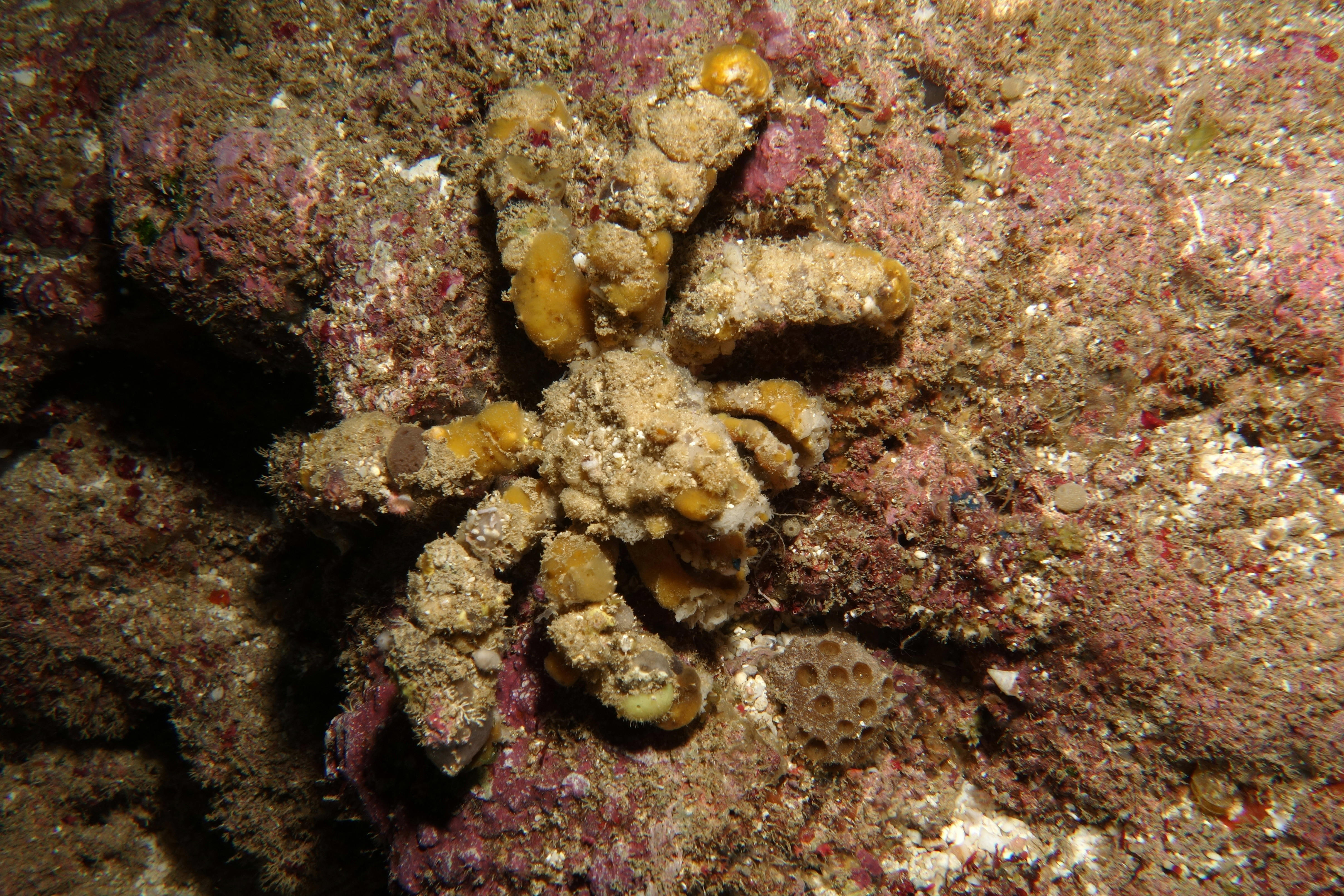 |
| Figure 5: A Velcro crab decorates itself to look like the rock it is on. Source: Patrick Randall. Obtained and accredited under fair use. [34] |
2.2 How do decorator crabs decorate?
Initially, it was thought that decorator crabs secreted a glue to stick decorations on their shells [7][8], but studies found that the materials attach to the hooked setae covering the crabs’ shells just like how Velcro works. The crabs use their chelae to pick up pieces of decorating material, and cut or tear them into pieces of suitable length and size [7][8][11]. The decorator crabs then use their mouthparts to soften the edges of the material before rubbing it against their shells to attach the material to the dense hooked setae covering their bodies [8][10][13].Having trouble visualising the decorating process? Watch the two videos below to see how decorator crabs attach all kinds of materials onto their bodies!
Video 1: How decorator crabs decorate themselves [35].
Video 2: A decorator crab decorating itself with a Zoanthid coral polyp [36].
These crabs usually decorate their carapace first before decorating other parts of their body [13], and in the case of the Velcro crab (Figures 6 & 7), every part of its shell is heavily decorated except its chelipeds [11]. When decorator crabs moult, they take off the decorations from their old shell and attach it to their new shell - watch a freshly moulted decorator crab recycle its decorations in the video below!
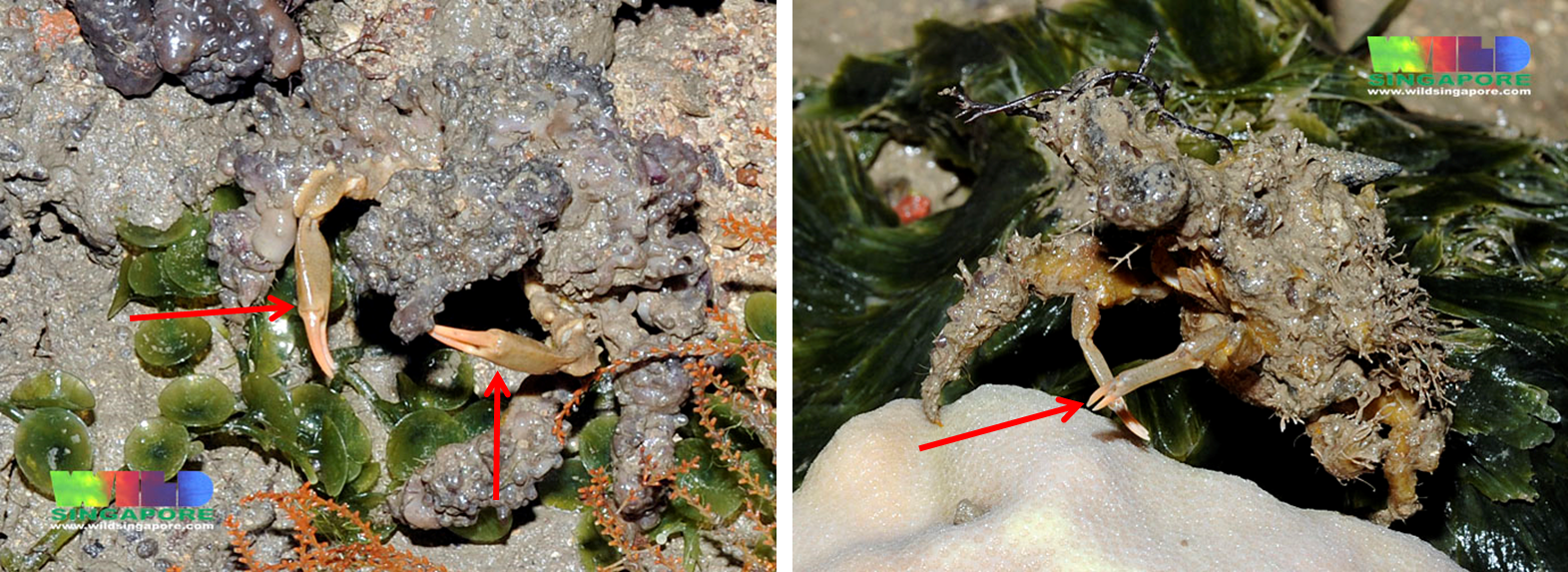 |
| Figures 6 (left) & 7 (right): The chelipeds of the Velcro crabs are left undecorated. Adapted from: Ria Tan. Permission granted. Edited by: Nicolette Loo. [37][38] |
Video 3: A decorator crab reusing its old decorations from its moult [39].
2.3 The cost-benefit trade-off of decorating
Although decorating is beneficial to decorator crabs by helping them stay hidden from predators, the act of decorating requires energy to and the crab has to expend more energy to carry the extra weight of decorations around [7][10][14]. Studies have found that the larger the species of decorator crab, the less the species decorates [7][8][10]. Also, in some species, as the crab grows from juvenile to adult, the extent of decoration decreases, and some species even stop decorating completely when they are adults [10][27]. This could be because the larger crabs are less vulnerable to predation as they have a thicker carapace and can defend themselves with their bigger claws [15][27], so the energetic costs of decorating outweigh the benefits of defence against predators. Over time, the larger species evolved to decorate less or completely not decorate at all [14]. On the other hand, camouflage is a more effective and important anti-predator defence for smaller decorator crabs, such as the Velcro crab. In fact, it is one of the smallest species and heaviest decorators amongst the decorator crabs, and it decorates throughout its life [7].One example of a large species of decorator crab that decorates less as it grows is the Sheep crab (Loxorhynchus grandis) (Figure 8). It's carapace can grow up to 16 cm in width. When the species reaches adulthood, it decorates its carapace minimally or stops decorating completely [14][28]. The amount of decoration on the Sheep crab in Figure 8 differs so much from that on the Velcro crab in Figure 9!
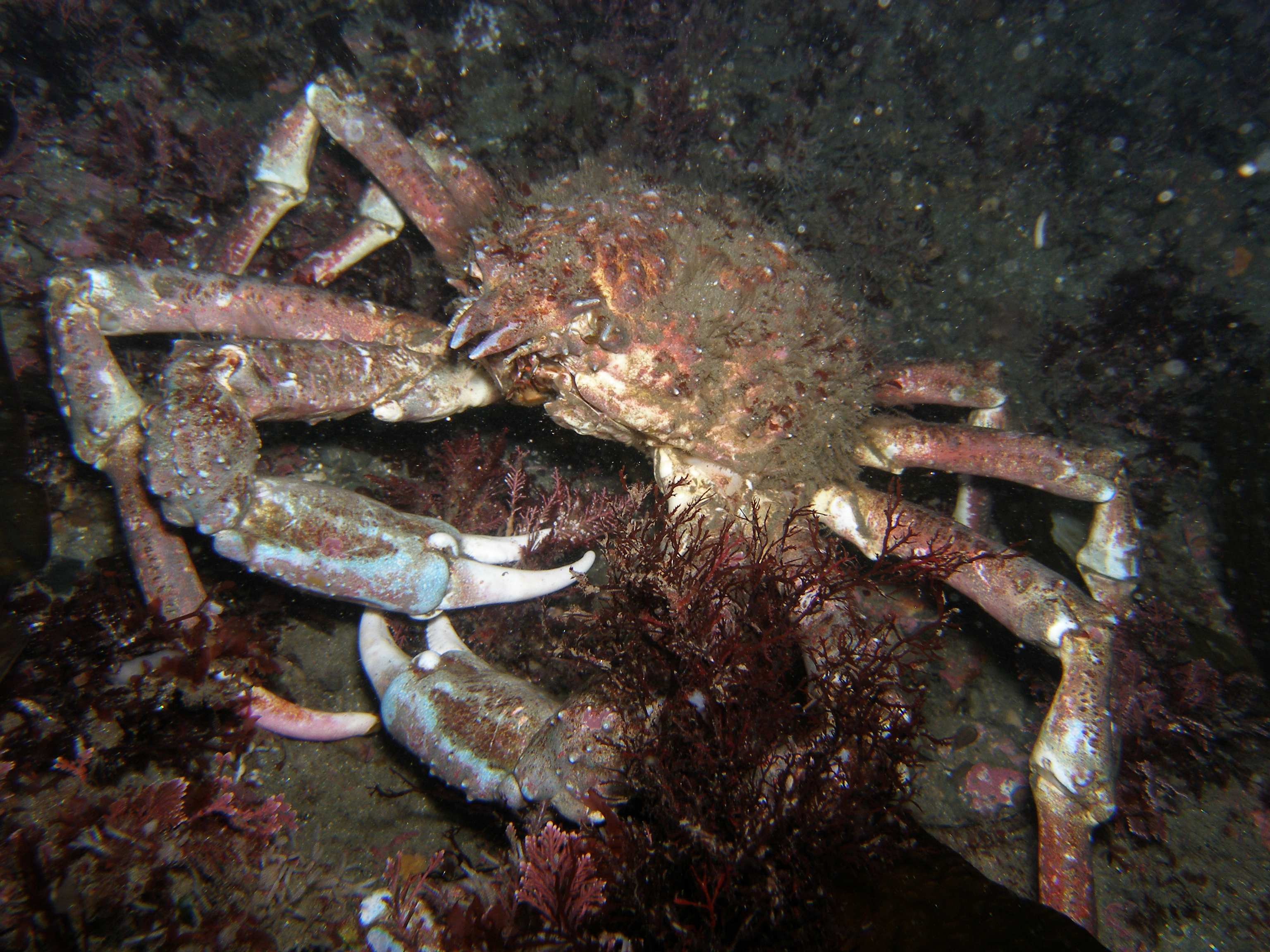 |
| Figure 8: A Sheep crab with a layer of algae on its carapace. Source: Klaus Stiefel. Obtained and accredited under fair use. [40] |
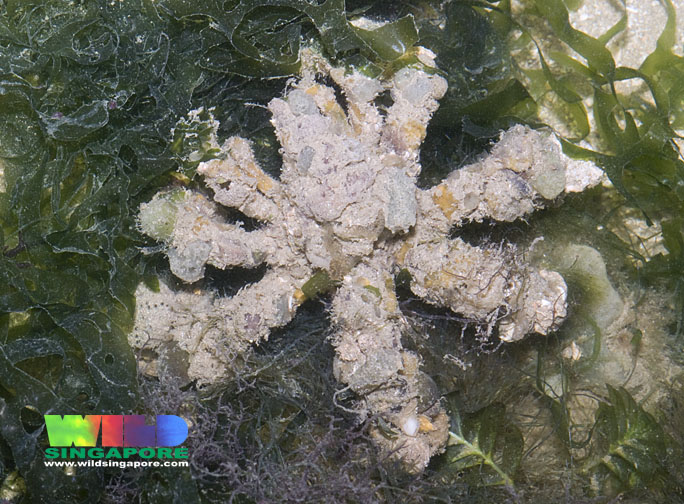 |
| Figure 9: Velcro crab. Source: Ria Tan. Obtained and accredited under fair use. [41] |
3. Distribution and Habitat
The Velcro crab can be found throughout the Indo-west pacific region [9][16], from East Africa to the Philippines to the French Polynesian islands (Figure 10).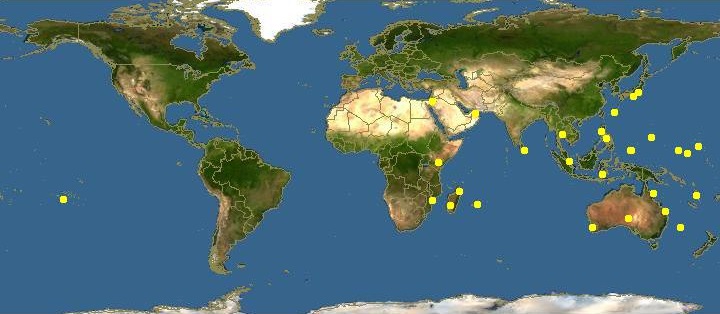 |
| Figure 10: Global distribution of the Velcro crab (Camposcia retusa). Source: Discover Life. For public use. [42] |
In Singapore, the Velcro crab can be found on the offshore islands, such as Pulau Ubin and the Southern islands, as well as on the coastal areas on the mainland, such as Changi beach, Tuas, East Coast Park and Tanah Merah (see map below) [48].
The Velcro crab inhabits rocky shores, coral reefs and seagrass beds, and can be found in the intertidal and subtidal zones [3][9]. The species has also been found in deeper waters of up to 200 m [3]! The intertidal zone is the area between the high and low tide marks, which means the area is submerged in water at high tide and above water at low tide. The subtidal zone is below the low tide mark, so it is always submerged in water (Figure 11).
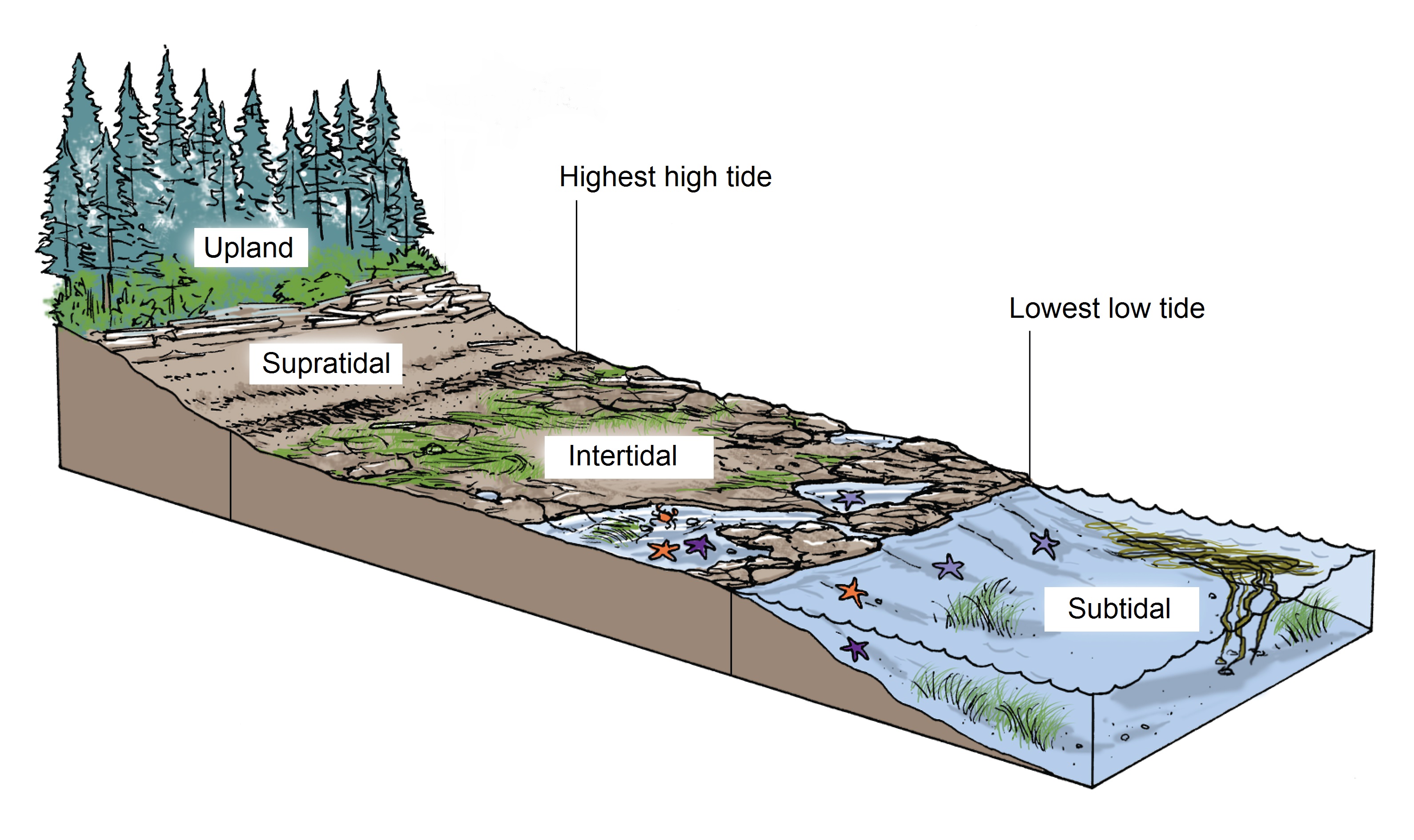 |
| Figure 11: Different zones of a coastal habitat. Illustration by: Soren Henrich. Permission granted. [43] |
4. Biology
4.1 Diet
The Velcro crab is a scavenger that feeds on dead organisms and decaying matter [17].4.2 Reproduction
There is a lack of research into the reproductive cycle of the Velcro crab. Reproduction in the Velcro crab is most likely similar to that of the other species of crabs in the same family (Inachidae). Male crabs have to first court their female counterparts [18]. For decorator crabs, decorations do not play a role in attracting mates, instead, some species rely on chemical signals [7]. However, these decorations can be advantageous in male-male competitions over a mate by making the crab look bigger than its competitor [7]. After mating, female crabs carry the eggs in their abdomen until they hatch into free-swimming zoea [18].5. Conservation and Threats
5.1 Conservation status
The Velcro crab has not been accessed for the IUCN red list and does not have an official conservation status. However, the species is listed as ‘Vulnerable’ under the Singapore red data book [9].Under the Singapore Red Data book classification, a species that is classified as 'Vulnerable' has a local population of between 250 to 1000 mature individuals, and there might be evidence of decline in populations numbers, small habitat range or habitat fragmentation [9].
5.2 Threats
Although an official conservation status has not been assigned to the species, it does not mean that the species is free from threats to its survival. One potential threat to the Velcro crab is the aquarium trade [9][16][19]. It is a popular species in the trade because of its hardiness to survive in aquariums compared to other decorator crabs [20] and because of its interesting decorating behaviour [19]. As such, the Singapore data book states that the collection of the species from Singapore should be limited or disallowed completely [9]. Although the Velcro crab is an interesting animal, if you spot it when visiting a coastal area, please do not bring it home as a pet. Also, if you are planning to purchase one for your aquarium, do check the origin of the crab - please do not purchase it if it was caught from the wild.On top of the threat from the aquarium trade, these crabs also face an additional threat in Singapore – habitat loss. This species inhabits rocky shores, which are being lost to development [9]. To date, there are only rocky shores found in Labrador Beach, Pulau Ubin and the Southern Islands [21]. The preservation of these rocky shore habitats is thus important in the conservation of the Velcro crab locally [22].
6. Taxonomy
6.1 Taxonomic Hierarchy
| Kingdom |
Animalia |
| Phylum |
Arthropoda |
| Subphylum |
Crustacea |
| Class |
Malacostraca |
| Order |
Decapoda |
| Infraorder |
Brachyura |
| Superfamily |
Majoidea |
| Family |
Inachidae |
| Genus |
Camposcia |
| Species |
Camposcia retusa |
6.2 Original description
While it is clear that Latreille is the original descriptor of the species, there are conflicts in the literature regarding the author citation for the species – some refer to the species as Camposcia retusa Latreille 1829, while others refer to it as Camposcia retusa (Latreille, 1829).In a journal written by Latreille in 1829, entitled “Les crustacés, les arachnides et les insectes, distribués en familles naturelles, ouvrage formant les tomes 4 et 5 de M. le Baron Cuvier sur le Règne animal (deuxième édition)”, the species Maia retusa and the genus Camposcia were mentioned on page 60, together with some physical descriptions (Figures 12 & 13).
Some authors regard the journal by Latreille (1829) as the original description of the species, but the species Maia retusa had already been mentioned by Latreille in another journal in 1817, so it is unclear if the journal by Latreille (1829) is the original description of the species. However, the description of Camposcia in Latreille (1829) did not refer to the specific species, hence it cannot be taken as the original description of the species as well. There are also no documents recording the switch in genus, so the different genus names could well be different combinations of scientific names given to the species.
The confusion could also be due to the different spellings of the scientific name in different records. In Latreille (1829), the species was referred to as Maia retuja – Ng, Guinot, & Davie (2008) later confirmed that “retuja” was a spelling error [24]. Some records by Latreille also referred to the species in French – using “Camposcie” and “retuse” – instead of Latin names [24].
Although there is no general consensus about the original name of the species, it has been established that the accepted scientific name for the species is Camposcia retusa, and Maia retusa is a synonym.
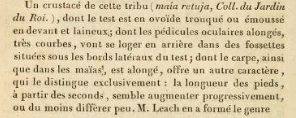 |
| Figure 12: Record of Maia retusa in Latreille (1829). Source: Harvard University, Museum of Comparative Zoology, Ernst Mayr. Not in copyright. [44] |
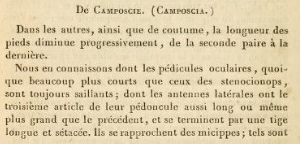 |
| Figure 13: Record of Camposcia in Latreille (1829). Source: Harvard University, Museum of Comparative Zoology, Ernst Mayr. Not in copyright. [45] |
6.3 Synonyms
- Maia retusa
6.4 Type information
The species was first described with a single female specimen, on the basis of monotypy, but there conflicts in the literature as to whether the type species is Maia retusa [24][25] or Camposcia retusa [26]. It is not known where the type specimen was collected from [25][26]. Currently, the status of the type and its location is unknown [26].6.5 Phylogeny
The genus Camposcia is a monotypic genus. Currently, the there are no studies on the phylogenetic relationship of Camposcia retusa to the species and genus levels. There have only been phylogenetic studies to the family level.Decorator crabs belong to the monophyletic superfamily Majoidea. The relationships between the species of Majoidea crabs have been constructed based on adult eyestalk, antennal morphology and larval morphology [29]. Phylogenetic trees constructed using these morphological data show that the family Inachidae is monophyletic.
Hultgren and Stachowicz (2008) were the first to study these relationships using molecular data from one nuclear locus (28S) and two mitochondrial loci (16S and CO1) [29]. The data was used to construct phylogenetic trees using Bayesian inference and Maximum Likelihood. Under the Bayesian method, molecular data from all three loci were combined to construct the phylogenetic tree. The constructed tree supports the previous studies that the family Inachidae, which the Velcro crab is a member of, is a monophyletic clade (Bayesian posterior probability support = 100) (Figure 14). Analyses using the maximum likelihood method analysed data from each loci separately (single loci dataset). For trees constructed using the 16S and 28S loci dataset, the bootstrap values for the support of the Inachidae clade are rather high (99 and 81 respectively). However, for the tree constructed by CO1 data, the bootstrap value for the Inachidae clade was less than 50 (table 1). The study also used Bayesian inference to construct trees with single loci datasets, and the Bayesian posterior probability support values were much higher (table 1).
As Bayesian posterior probability support values can often be inflated relative to bootstrap values from maximum likelihood, the results from the study do not provide strong support for the monophyly of the family Inachidae. Another tree could be constructed using maximum likelihood and maximum parsimony with the combined dataset to see if the findings support the results from the Bayesian inference method. Moreover, this study only analysed molecular data from two species of crabs from the Inachidae family, so the results might not be conclusive.
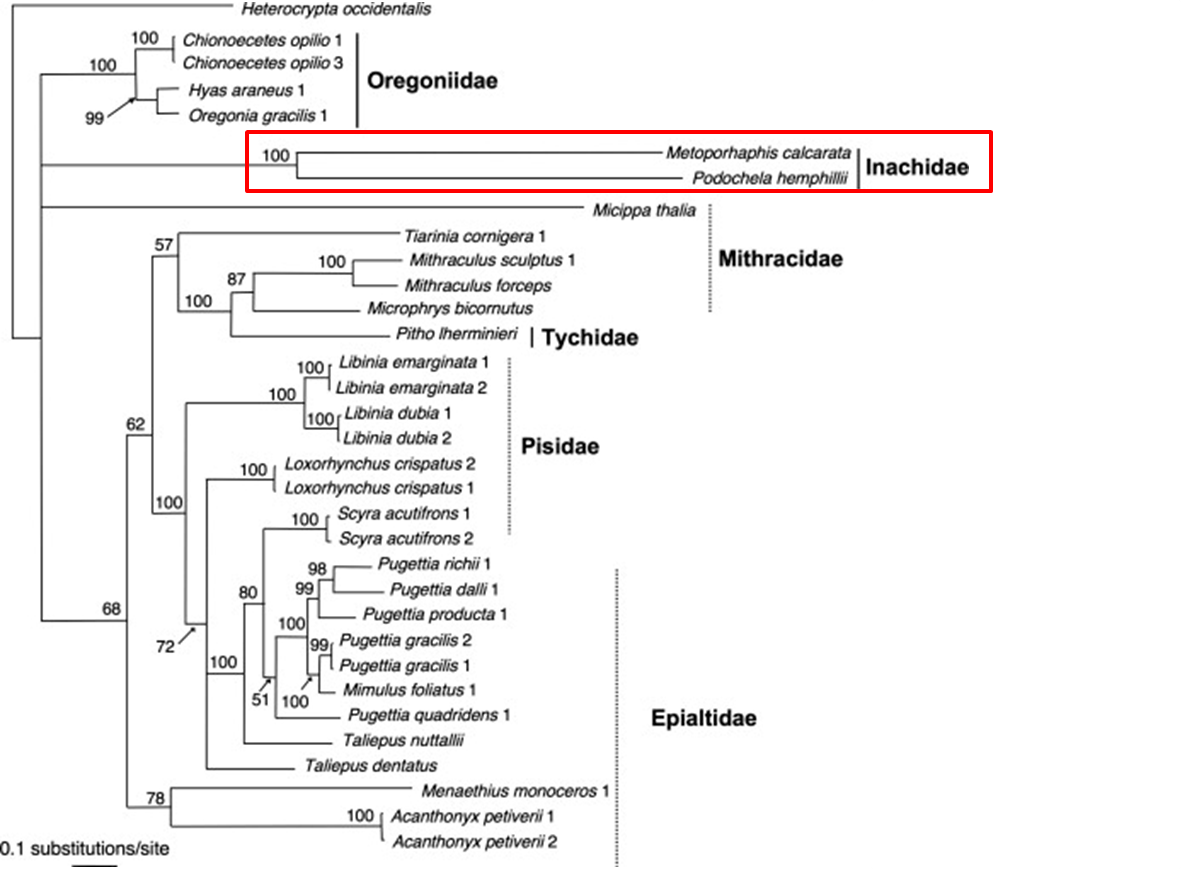 |
| Figure 14: Phylogenetic tree of the decorator crabs (superfamily: Majoidea), shown as a Bayesian consensus tree. Adapted from: Hultgren & Stachowicz (2008). Permission granted. Edited by: Nicolette Loo. [46] |
| Table 1: Bootstrap (maximum likelihood) and posterior-probability (Bayesian) values for selected clades resolved by single-locus and combined dataset trees using different methods. By Hultgren & Stachowicz (2008). [47] |
6.6 DNA Barcoding
The entire genome of the Velcro crab has yet to be sequenced, but a region of the CO1 gene has been sequenced and recorded in the Barcode of Life Data Systems. The record can be found here.7. Glossary
Carapace: the hard upper shell of a crustacean, tortoise or arachnidChela (singular): a pincer-like claw, especially of a crab or other crustacean
Cheliped: one of the pair of legs that bears the chelae
Pereiopod: each of the eight walking limbs of a crustacean such as a crab or lobster, growing from the thorax
Zoea: the larval form of certain crustaceans, such as crabs
{Back to physical description] [Back to reproduction]
8. References
- Knight, C. (1839). The Penny Cyclopædia of the Society for the Diffusion of Useful Knowledge (Vol. 14). London: Charles Knight and Co.
- Barnard, K. H. (1950). Descriptive catalogue of South African decapod crustacea. Annals of the South African Museum, 38, 1-837.
- Poupin, J., & Juncker, M. (2010). A guide to the decapod crustaceans of the South Pacific. Noumea, New Caledonia: Secretariat of the Pacific Community.
- Tan, L. W., & Ng, P. K. (n.d.). Velcro crab. Retrieved November 3, 2016, from A Guide to Seashore Life: http://mangrove.nus.edu.sg/pub/seashore/text/188.htm
- Griffin, D. J., & Tranter, H. A. (1986). Majidae. In The Decapoda Brachyura of the Siboga Expedition (p. 22). Leidon: BRILL.
- Griffin, D. J. (1966). A review of the Australian majid spider crabs (Crustacea, Brachyura). Australian Zoology, 13(3), 259-298.
- Castro, P., Davie, P., Guinot, D.G., Schram, F., & Klein, C.v. (2015). The Crustacea: Brachyura. Treatise on Zoology - Anatomy,Taxonomy, Biology, 9.
- Wicksten, M. K. (1980). Decorator crabs. Scientific American, 242, 146-154.
- Davison, G. W., Ng, P. K., & Ho, H. C. (2008). The Singapore Red Data Book (2nd ed.). Singapore: Nature Society (Singapore).
- Hultgren, K., & Stachowicz, J. J. (2011). Camouflage in decorator crabs: integrating ecological, behavioural and evolutionary approaches. Animal camouflage, 214-229.
- Tan, R. (2012, December). Velcro Crab. Retrieved November 2, 2016, from Wild Fact Sheets: http://www.wildsingapore.com/wildfacts/crustacea/crab/majoidea/retusa.htm
- Stachowicz, J. J., & Hay, M. E. (1999). Reducing predation through chemically mediated camouflage: indirect effects of plant defenses on herbivores. Ecology, 80(2), 495-509.
- Wicksten, M. K. (1993). A review and a model of decorating behaviour in spider crabs (Decapoda, Brachyura, Majidae). Crustaceana, 64(3), 314-325.
- Berke, S. K., & Woodin, S. A. (2008). Energetic costs, ontogenetic shifts and sexual dimorphism in spider crab decoration. Functional Ecology, 22(6), 1125-1133.
- Ruxton, G. D., & Stevens, M. (2015). The evolutionary ecology of decorating behaviour. Biology letters, 11(6).
- Calado, R., Lin, J., Rhyne, A. L., Araújo, R., & Narciso, L. (2003). Marine ornamental decapods—popular, pricey, and poorly studied. Journal of crustacean biology, 23(4), 963-973.
- Ng, P. K., Corlett, R., & Tan, H. T. (2011). Singapore biodiversity: an encyclopedia of the natural environment and sustainable development. (D. Millet, Ed.)
- Le Bris, S., Bodilis, P., & Pean, M. (2016, April 7). Camposcia retusa (Latreille, 1829). Retrieved November 5, 2016, from Data of Observations for Recognition and Identification fauna and flora Subaquatiques: http://doris.ffessm.fr/Especes/Camposcia-retusa-Crabe-decorateur-1251
- Kazmi, Q. B., & Kazmi, M. A. (2011). Ornamental crustaceans of Pakistan — ricey but poorly studied. 31st Pakistan congress of zoology.
- Tygesen, K. T. (n.d.). Decorator crab (Camposcia retusa). Retrieved November 8, 2016, from https://reefapp.net/en/lex/details/camposcia-retusa
- Lee Kong Chian Natural History Museum. (n.d.). Rocky Shore. Retrieved November 2, 2016, from http://lkcnhm.nus.edu.sg/dna/habitats/details/4
- National Parks Board. (n.d.). Camposcia retusa. Retrieved November 2, 2016, from NParks Flora & Fauna Web: https://florafaunaweb.nparks.gov.sg/special-pages/animal-detail.aspx?id=128
- Davie, P. (2015). Camposcia retusa. Retrieved November 8, 2016, from World Register of Marine Species: http://www.marinespecies.org/aphia.php?p=taxdetails&id=208891
- Ng, P. K., Guinot, D., & Davie, P. J. (2008). Systema Brachyurorum: Part I. An annotated checklist of extant brachyuran crabs of the world. The Raffles Bulletin of Zoology, 17.
- Ward, M. (1942). Notes on the Crustacea of the Desjardins Museum, Mauritius Institute with Descriptions of New Genera and Species. The Mauritius Institute Bulletin, 2, 49-113.
- Davie, P. J. (2002). Crustacea: Malacostraca. Eucarida (Part 2). Decapoda - Anomura, Brachyura. Victoria, Australia: CSIRO Publishing.
- Hultgren, K. M., & Stachowicz, J. J. (2009). Evolution of decoration in majoid crabs: a comparative phylogenetic analysis of the role of body size and alternative defensive strategies. The American Naturalist, 173(5), 566-578.
- Wicksten, M. K. (1979). Decorating behavior in Loxorhynchus crispatus Stimpson and Loxorhynchus grandis Stimpson (Brachyura, Majidae). Crustaceana, 37-46.
- Hultgren, K. M., & Stachowicz, J. J. (2008). Molecular phylogeny of the brachyuran crab superfamily Majoidea indicates close congruence with trees based on larval morphology. Molecular Phylogenetics and Evolution, 48(3), 986-996.
- “Figure 1: Velcro crab” by Michael Pollack. Permission granted. URL: http://www.untamedimages.com/komodo/
- “Figure 2: Undecorated Velcro crab”. Adapted from Martin Lagerway. [CC BY-NC-SA 2.0 (https://creativecommons.org/licenses/by-nc-sa/2.0/)]. Modifications: added labels. URL: https://www.flickr.com/photos/66925960@N08/6252618404/
- “Figure 3: Hooked setae and man-made Velcro”. Adapted from Hultgren & Stachowicz in [10]. Permission granted. Modifications: added annotations.
- “Figure 4: Can you spot the Velcro crab?” by Ow Yong Wei Long, own photo. Obtained through personal communication.
- “Figure 5: A Velcro crab decorates itself to look like the rock it is on” by Patrick Randall. [CC BY-NC-SA 2.0 (https://creativecommons.org/licenses/by-nc-sa/2.0/)] URL: https://www.flickr.com/photos/animaliaproject/6517790619/
- “Video 1: How decorator crabs decorate themselves”. Source: BBC Earth, obtained and accredited under fair use. URL: https://www.youtube.com/watch?v=MYyFTK0C4Nw
- “Video 2: A decorator crab decorating itself with a Zoanthid coral polyp”. Source: stlreefer85, obtained and accredited under fair use. URL: https://www.youtube.com/watch?v=k5bsyHpTZAA
- “Figure 6 (left): The chelipeds of the Velcro crabs are left undecorated”. Adapted from Ria Tan. Permission granted. Modifications: added arrows. URL: https://www.flickr.com/photos/wildsingapore/4748958312/
- “Figure 7 (right): The chelipeds of the Velcro crabs are left undecorated”. Adapted from Ria Tan. Permission granted. Modifications: added arrow. URL: https://www.flickr.com/photos/wildsingapore/4748957186/
- “Video 3: A decorator crab reusing its old decorations from its moult”. Source: theyangman, obtained and accredited under fair use. URL: https://www.youtube.com/watch?v=FusSJD_FxdI
- “Figure 8: A Sheep crab with a layer of algae on its carapace”, by Klaus Stiefel. [CC BY-NC 2.0 (https://creativecommons.org/licenses/by-nc/2.0/)] URL: https://www.flickr.com/photos/pacificklaus/3876670216/
- “Figure 9: Velcro crab”, by Ria Tan. [CC BY-NC-ND 2.0 (https://creativecommons.org/licenses/by-nc-nd/2.0/)] URL: https://www.flickr.com/photos/wildsingapore/8226002243/
- “Figure 10: Global distribution of the Velcro crab (Camposcia retusa)". Source: Discover Life. For public use. URL: http://www.discoverlife.org/mp/20m?map=Camposcia+retusa
- “Figure 11: Different zones of a coastal”. Source: Biodiversity BC. Illustration by: Soren Henrich, Watershed Moment Communication. Permission granted. Obtained through personal communication.
- “Figure 12: Record of Maia retusa in Latreille (1829)". Digitised by: Harvard University, Museum of Comparative Zoology, Ernst Mayr. Not in copyright. URL: https://archive.org/stream/lescrustacsles01latr#page/60/mode/2up
- “Figure 13: Record of Camposcia in Latreille (1829). Digitised by: Harvard University, Museum of Comparative Zoology, Ernst Mayr. Not in copyright. URL: https://archive.org/stream/lescrustacsles01latr#page/60/mode/2up
- “Figure 14: Phylogenetic tree of the decorator crabs (superfamily: Majoidea), shown as a Bayesian consensus tree”. Adapted from Hultgren & Stachowicz in [29]. Permission granted. Modifications: highlighted relevant section.
- “Table 1: Bootstrap (maximum likelihood) and posterior probability (Bayesian) values for selected clades resolved by single-locus and combined dataset trees using different methods”. Source: Hultgren & Stachowicz in [29].
- "Distribution of Camposcia retusa in Singapore". Adapted from: Ria Tan. URL: https://www.flickr.com/photos/wildsingapore/tags/Camposcia%2520retusa/map?&fLat=1.2622&fLon=103.8661&zl=11&order_by=recent